The device of the valve on a gas cylinder and methods for replacing it if necessary
Cylinders are universal equipment for the storage and transportation of gaseous substances for domestic and industrial purposes. Shut-off valves in them are not eternal, therefore, over time, valve replacement on a gas cylinder is required. You can make it yourself in compliance with a number of safety rules.
We will tell you how to choose the right valve for equipping a gas cylinder. For independent masters, we provide detailed instructions for changing a worn fixture. Here you will find out what safety measures you must follow when installing the shut-off device on the gas tank.
The content of the article:
Gas cylinder components
Requirements for production processes and technical characteristics of gas cylinders are regulated by the rather old GOSTs 949-73 and 15860-84.
The maximum working pressure in the devices varies from 1.6 MPa to 19.6 MPa, and the wall thickness can vary from 1.5 to 8.9 mm.
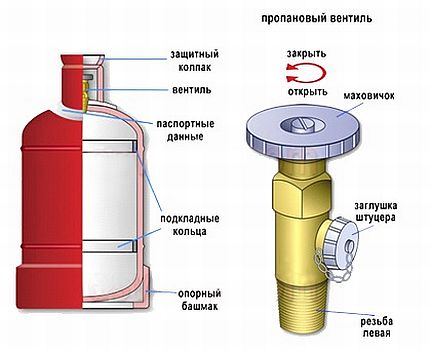
The standard gas cylinder assembly consists of the following elements:
- Cylinder body.
- Valve with shutoff valves.
- Closing valve cap.
- Lining rings for fixing and transportation.
- Support shoe.
An important element of the cylinder is also the technical information stamped on it.
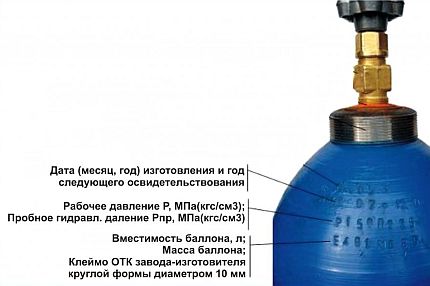
The bottom of the cylinders has the shape of a hemisphere for a uniform distribution of internal pressure.For better stability of the body, a shoe is welded from the outside, on the lower edges of which there are often openings for attaching the cylinder to horizontal surfaces.
With types of gas cylinders and features of their labeling will introduce the articlewhich we recommend viewing and reading.
Types and arrangement of valves
The gas valve valves have a thread that is standardized, but they themselves can have a variety of designs. The type of chemical stored, production features of operation and the amount of money influence the choice of valve model.
Before buying new equipment, you should familiarize yourself with the options for execution and with the internal structure of the valves.
Classification of valves for cylinders
The design features of gas cylinder valves are not due to the whims of engineers, but to safety considerations.
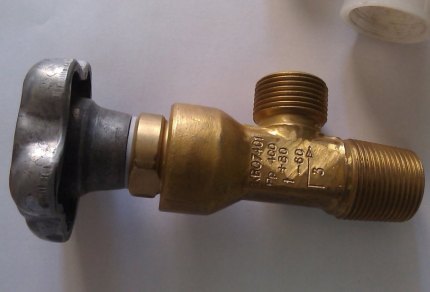
Depending on the material of execution, stop valves are divided into brass and steel. The choice of metal for the manufacture of the valve body is determined by the type of gas contained in the cylinder.
The following types of stopcocks are distinguished, depending on the type of chemicals stored:
- Acetylene. The body of such cylinders is painted white. Special valves are used in cylinders with acetylene, chlorine, ammonia and other aggressive substances.
- Oxygen. Cylinders are painted blue and are intended for the storage of oxygen, argon, hydrogen, nitrogen, carbon dioxide and other inert gases.
- Propane butane. They are painted red and are intended for storage of substances and other gaseous hydrocarbons corresponding to the name. The most common valve type model for such a cylinder is VB-2.
Valves for acetylene cylinders are not made of brass, because the substances contained in them can react chemically with copper. Typically, carbon or alloy steel is used to make valves of this type.
Gas valve device
The standard gas valve looks like a tee, on each fitting of which an external thread is cut. More advanced models may have an additional protrusion - a safety valve. Its purpose is to relieve excess pressure in the event of a full cylinder heating or when filling is improperly performed.
The lower valve nipple is used to connect to a gas cylinder, the upper one is used to fasten the flywheel, and the lateral one is used to connect communications for gas outlet and injection. A gas cylinder tap is quite simple.
Shutoff valves usually consist of the following common elements:
- Brass or steel case.
- Stuffing box or handwheel connecting to the housing with a union nut.
- Internal locking mechanism with valve and stem.
- Gaskets.
- Outlet cap.
It is possible to consider in detail the arrangement of valves on gas cylinders of each type in the presented images.
Worn valves may allow a small amount of gas to pass through, which in closed rooms can lead to unpredictable consequences. To prevent such situations, a cap is used on the side fitting, which serves to additionally seal the container during transportation and long-term storage.
The direction of the thread at the outlet depends on the chemicals that are contained in the cylinders: the right one is used for non-combustible gases (oxygen, nitrogen, argon, etc.), and the left one is used for combustibles (hydrogen, acetylene, propane, etc.)
The principle of operation of the gas valve in assembled form is not remarkable. To supply gas and block it, simply turn the handwheel slowly in the appropriate direction.
Mandatory Precautions
Before replacing the gas cylinder valve, safety precautions must be taken. Work must be carried out in such a way as to protect a person from potential hazards and keep the equipment in working condition.
The following precautions are used during the preparatory work to replace the gas valve:
- Bleed the remaining contents of the container can only be in the open. An exception can be made only for nitrogen, air and argon.
- The work area should be well ventilated, although it is advisable to carry out work on the street.
- Only one closed gas cylinder should be inside the workplace.
- Loosen the flywheel slowly to prevent electrification.
- Replacement of the valve can only be started after the final pressure equalization in the cylinder and outside.
When screwing the valve into the cylinder, a fum tape or special lubricants are used, which provide increased tightness and strength of the connection. When replacing the valve, such seals greatly complicate the process of dismantling it. To solve this problem, you can heat the valve with a hairdryer.
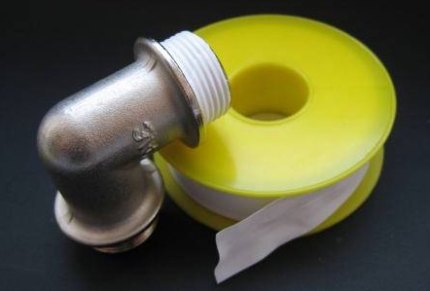
Shutoff valves can be heated only after bleeding the gas from the cylinder and closing the valve. In this case, the procedure is safe and will not lead to unpredictable situations.
An alternative to a hairdryer can be wrapping the valve with a cloth, followed by pouring boiling water over it. With this heating method, any suitable plug should be screwed onto the outlet fitting to prevent water from entering it.
After observing all safety precautions and warming up the shut-off valves, you can proceed to unscrew the valve, which at home can be a difficult task.
If, in addition to replacing the cylinder locking device, you also need crane replacementinstalled on the gas pipeline, we advise you to study the procedure and rules for performing this work.
Valve Unscrewing Guide
An additional reserve of tightness is not superfluous, but when replacing shut-off valves on a gas cylinder, the strength of its fastening can be a big problem. The difficulty lies in fixing the body of the container so that it does not rotate when the valve is unscrewed with a key.
It is with this problem in mind that further step-by-step steps will be considered to replace the stop valves. You can fix the body of a gas cylinder in many ways, consider some of them.
Method 1: Attaching the Limit Bar
You will need such tools and materials: a pipe wrench, two bolts with a length of 20 mm or more with two nuts and a metal angle profile of at least a meter in length. Instead of a corner, you can use any other product in which it is not a pity to drill two small holes.
Next, you need to measure the distance between the two nearest holes on the shoe of the container and drill the corresponding holes from one edge of the metal profile.After that, fasten the iron bar to the cylinder body with the help of bolts and put it on its side. This design will not allow the cylinder to scroll.
Then you need to put your foot on the metal profile, and with your hand, using the key, carefully unscrew the valve.
A step-by-step photo-instruction of the process is presented below.
Method 2: welding the cylinder to a metal base
This method is quite dangerous, therefore it should be used only by a professional welder with utmost care. The shoe is seized in two places so that after unscrewing the valve, it was easy to tear the container off the base.
After welding the housing, the fittings are carefully unscrewed using a pipe wrench. Then the internal thread of the cylinder should be cleaned of the remnants of the seal.
The described options for fixing the gas cylinder are not limited. To fix it, you can use many alternative methods. Liquid condensate sometimes accumulates at the bottom of the container, so after removing the valve, it is necessary to turn the container over so that water can flow out of it.
Screwing on new stop valves
Before screwing in the valve, all connected parts must be degreased to prevent clogging of the locking mechanism. To do this, you can use a rag with ordinary detergent or moistened with white alcohol. After this, rinse the surfaces with plain water and allow them to dry.
A new valve is never screwed onto a bare thread cylinder. It is imperative to use a sealant: special thread grease or fluoroplastic fum tape. They are applied to the lower fitting and only after that the valve is turned on.
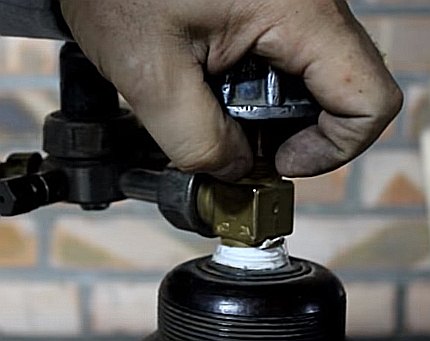
The thickness of the gas fum tape is more than plumbing and is 0.1 - 0.25 mm, and its bobbin should be yellow. A tape is wound with a tension of 3-4 layers. It is better to twist it once again at break than to make the seal loose.
Clamp the valve preferably with a torque wrench. Steel shut-off valves are screwed with a maximum force of 480 Nm, and brass - 250 Nm. After clamping the valve, you can proceed to the next steps to test the tightness of the resulting connection.
Leak test and completion
When checking the valve connection for leaks, it will be necessary to pump gas under pressure into the gas cylinder.
There are two ways to do this:
- Inject gas using compressor equipment or a car pump.
- Connect two cylinders with a hose, the first of which is empty (tested), and the second is filled with gas.
First, under the control of the pressure gauge, it is necessary to fill the test cylinder with gas with a pressure of 1.5-2 atmospheres. After that, soap foam is applied to the joint and the tap is slightly opened.
If soap bubbles are not inflated anywhere, then the connection is tight. But if at least slight swelling of the foam appears, you will have to twist the valve again.
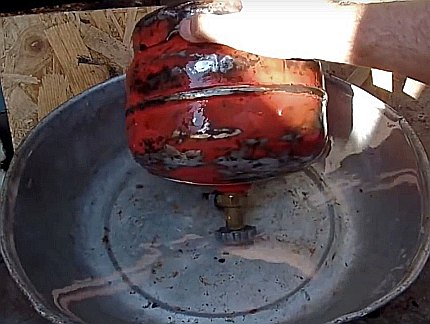
If the container is small, then you can immerse its valve in a small basin of water and see the presence of bubbles.
After replacing the shut-off valves in the passport of gas cylinders, a corresponding mark must be affixed.
It should be remembered that the methods described above for replacing an old valve are applicable only to metal tanks. If you composite gas storage cylinder, you can’t act like that because of the possibility of damaging the flask and breaking its tightness.
Conclusions and useful video on the topic
The presented video materials allow you to see firsthand all the details and difficulties when replacing a valve on gas cylinders.
Video # 1. Unscrewing the valve from the gas cylinder:
Video # 2. Tightening a new valve with an original way to fix a gas cylinder:
Video # 3. How to replace the valve on a gas cylinder:
When performing work on replacing the gas valve, you need not to rush and consider each subsequent action and its consequences.
Even with all the precautions, the described manipulations with gas equipment are quite dangerous for a beginner. It is best to entrust the work to professionals who will produce them at a specialized stand.
If you have any questions while reading this article, you can ask them in the box below. Here you can leave comments and share useful information. Please comment on the material, we are interested in your opinion.

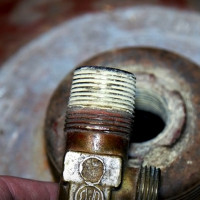 How to unscrew a valve on a gas cylinder: safe ways to disconnect a valve
How to unscrew a valve on a gas cylinder: safe ways to disconnect a valve 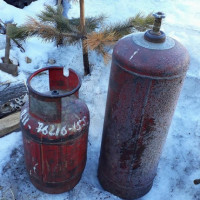 Why is a gas cylinder covered with hoarfrost: causes of freezing of gas in the cylinder and ways to prevent it
Why is a gas cylinder covered with hoarfrost: causes of freezing of gas in the cylinder and ways to prevent it 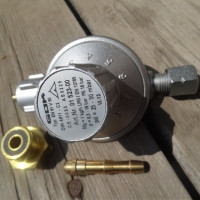 Why the gas cylinder gearbox buzzes: what to do if the gas pressure regulator is noisy
Why the gas cylinder gearbox buzzes: what to do if the gas pressure regulator is noisy 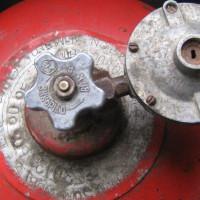 How to flush a gas bottle: safe ways to flush the receiver
How to flush a gas bottle: safe ways to flush the receiver 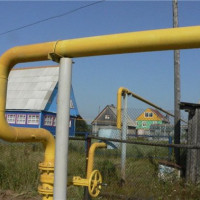 Cable for heating a gas pipe: device, selection according to parameters, installation methods
Cable for heating a gas pipe: device, selection according to parameters, installation methods  How to disassemble a gas cylinder: step by step instructions + precautions
How to disassemble a gas cylinder: step by step instructions + precautions  How much does it cost to connect gas to a private house: the price of organizing gas supply
How much does it cost to connect gas to a private house: the price of organizing gas supply  The best washing machines with dryer: model rating and customer tips
The best washing machines with dryer: model rating and customer tips  What is the color temperature of light and the nuances of choosing the temperature of the lamps to suit your needs
What is the color temperature of light and the nuances of choosing the temperature of the lamps to suit your needs  Replacement of a geyser in an apartment: replacement paperwork + basic norms and requirements
Replacement of a geyser in an apartment: replacement paperwork + basic norms and requirements
I came across your article and it surprised me. I did not think that if a gas leak was detected from the valve, it could still be repaired by hand. In my garden there is such a cylinder in the kitchen. Sometimes I change it if the gas runs out. When exchanging, they give out another cylinder (I don’t like it), old ones come across. Personally, my opinion is that not everyone will undertake valve repair. It’s easier to buy a new bottle. But if someone needs this, then a specially trained person should be engaged.
The main thing is that the hands from the right place, and the brains. Every straightforward person can repair the valve. In this case, the main thing is to carefully think through everything, find out the scheme of your valve (find the scheme of the type of valves that you are going to repair) and work strictly observing the safety requirements. Everything is real, and not only with propane. Only ATTENTION: MEMBRANE VALVES FILLED WITH GASES, DO NOT REPAIR IN ANY EVENT! Will shoot the valve in the sky.
Hmm, I expected more specifics on gates, alas, but a pity.
I have some old gas cylinders with valves, I want to change them to valves, because they no longer fill up with valves. The question is - what is the better to seal the thread and are there any other nuances.
After refueling, propane poisons the valve. Valve VT-2. What can be done?
Hello. In general, it is strange that they did not check the leak during refueling, it is their responsibility. And the question for you is this - an answer requires clarification, are you sure that the VT-2 valve, and not the VB-2?
Hello. When opening the valve on a fully refilled gas cylinder No. 1 (to supply gas to the gas stove), no gas flows. Put the bottle number 2 - the gas went. That is, the case in cylinder No. 1. What m. cause? In the valve? If “yes”, then what kind of malfunction prevents the gas supply from the cylinder in the valve position “open”?
And here in my balloon “wavers” with a bucket of liquid! I unscrew the valve, I twist it - there is NO JUST !!! GAS DOES NOT EXIT! There is NO ODOR AT ALL!
What to do? I completely unscrewed the top nut and threaded under the valve stem - nothing happened. He looked inside: some debris. It looks like a fragile box. Picked it in pieces. one remained “bitten” between the square of the lower stem and the body.
I think - this is the reason for the “freezing” of the exhaust valve. What can you guys tell me about this issue? I will cut the cylinder for other purposes!
Hello! Tell me! Slightly close the lamb on a large gas cylinder, and after a while it opens with difficulty, as if it were being pulled with a wrench